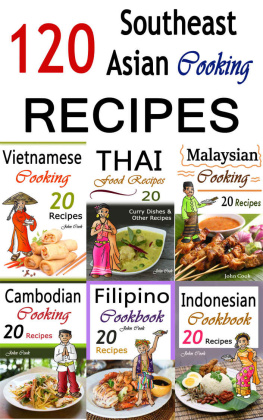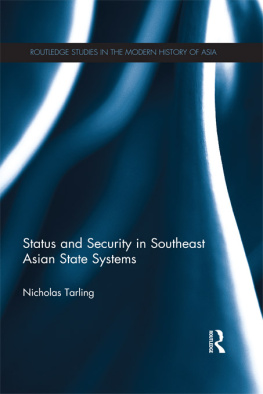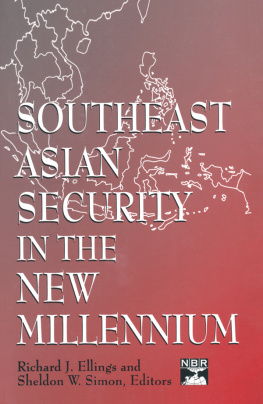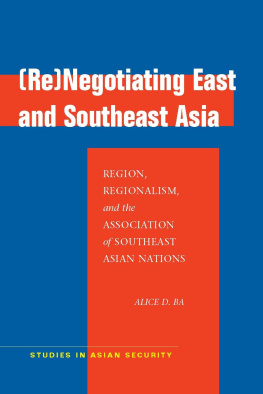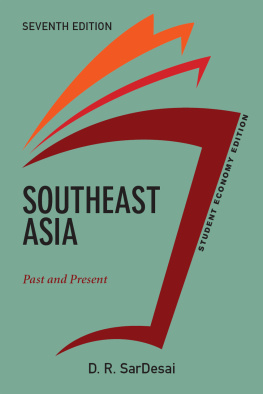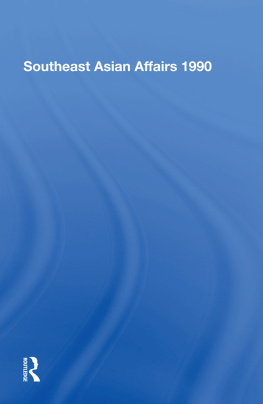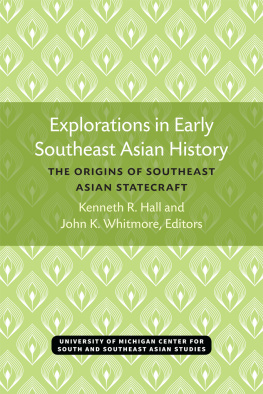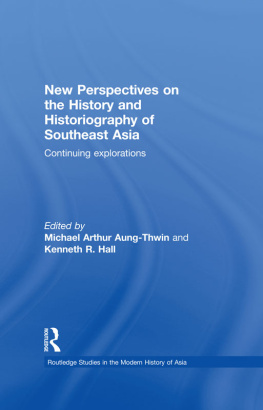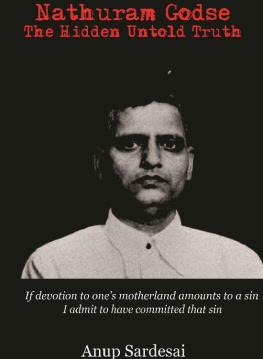Southeast Asian History
First published 2013 by Westview Press
Published 2018 by Routledge
711 Third Avenue, New York, NY 10017, USA
2 Park Square, Milton Park, Abingdon, Oxon OX14 4RN
Routledge is an imprint of the Taylor & Francis Group, an informa business
Copyright 2013 by Taylor & Francis
All rights reserved. No part of this book may be reprinted or reproduced or utilised in any form or by any electronic, mechanical, or other means, now known or hereafter invented, including photocopying and recording, or in any information storage or retrieval system, without permission in writing from the publishers.
Notice:
Product or corporate names may be trademarks or registered trademarks, and are used only for identification and explanation without intent to infringe.
Every effort has been made to secure required permissions for all text, images, maps, and other art reprinted in this volume.
Designed by Linda Mark
Library of Congress Cataloging-in-Publication Data
Southeast Asian history : essential readings / edited by D.R. SarDesai.2nd ed.
p. cm.
Includes bibliographical references and index.
ISBN 9780-813348575 (pbk. : alk. paper)ISBN 9780-813348582 1.
Southeast AsiaHistory. I. SarDesai, D. R.
DS526.7.S6865 2013
959dc23
2012038982
ISBN 13: 978-0-8133-4857-5 (pbk)
I want to thank the following publishers, institutions, and individuals for permission to reprint:
Ian W. Mabbett, The Indianization of Southeast Asia: Reflections of the Pre-historic Sources, Journal of Southeast Asian Studies, 8, (March 1977) pp. 114, reprinted with the permission of Cambridge University Press.
Robert Heine-Geldern, Conceptions of State and Kingship in Southeast Asia, Far Eastern Quarterly, 2 (1942), pp. 1530, reprinted with the kind permission of the Association for Asian Studies.
Keith W. Taylor, The Birth of Vietnam (Berkeley and Los Angeles: University of California Press, 1983), pp. 334339, reprinted with the kind permission of the publisher.
C. C. Brown, trans. Sejarah Malayu (The Malay Annals), Journal Malaya Branch Royal Asiatic Society, 25, 23 (1952), pp. 5259, reprinted with the kind permission of the Society.
John Leddy Phelan, The Hispanization of the Philippines: Spanish Aims and Filipino Responses, 15651700. Copyright 1959 by the Board of Regents of the University of Wisconsin System. Reprinted by permission of the University of Wisconsin Press.
Raden Adjeng Kartini, Letters of a Javanese Princess(Lanham, MD: University Press of America, 1985), pp. 5564, reprinted with the kind permission of the publisher.
Jos Rizal, Mi Ultimo Adis, in Rizals Poems, III, 1, Manila: National Historical Commission, 1972, pp. 160162, reprinted with the kind permission of the National Historical Commission of the Philippines.
U Nu, Saturdays Son: Memoirs of the Former Prime Minister of Burma (New Haven: Yale University Press, 1975), pp. 102113, reprinted with the kind permission of the publisher.
Elly Touwen-Bouwsma, The Indonesian Nationalists and the Japanese Liberation of Indonesia: Visions and Reactions, Journal of Southeast Asian Studies 27 (March 1996): 118, reprinted with the permission of Cambridge University Press.
Ben Kiernan, The Pol Pot Regime: Race, Power and Genocide in Cambodia, 19751979 (New Haven, CT: Yale University Press), 1996, pp. 927, reprinted with the kind permission of the publisher.
Aung San Suu Kyi, Freedom from Fear, in Freedom from Fear and Other Writings, revised edition, foreword by Vaclav Havel, translated by Michael Aris, translation copyright 1991, 1995 by Aung San Suu Kyi and Michael Aris. Used by permission of Viking Penguin, a division of Penguin Group (USA) Inc.
Greg Fealy, Islam in Southeast Asia: Domestic Pietism, Diplomacy and Security, in Mark Beeson, ed., Contemporary Southeast Asia: Regional Dynamics, National Differences (Hampshire, UK: Palgrave Macmillan, Houndmills, 2004), pp. 136155, reprinted with the kind permission of the publisher.
Since the first edition of this book appeared in 2006, I have received a large number of expressions of appreciation from faculty teaching the history of Southeast Asia. They cite the immense usefulness of the readings in illuminating the classroom presentation of many episodes in the regions historical development. At the same time, I have received many a suggestion on what can be deleted or replaced to suit the changing emphasis in Southeast Asian history.
I must specially thank my esteemed professional colleagues at various universities who reviewed the first edition carefully and sent in their most valuable suggestions. These are: Professors Arnold P. Kaminsky, California State University, Long Beach; Nguyen Thi Dieu, Temple University; Paul Mayle, Mount Vernon Nazarene University; Nhung Tuyet Tran, University of Toronto; Michael G. Vann, California State University, Sacramento; Pamela Sodhy, Georgetown University; Marc T. Russell, Old Dominion University; C. Michele Thompson, Southern Connecticut State University; and Chandrika Paul, Shippensburg University.
I have indeed accepted many of their suggestions. If I have not been able to use their other recommendations, it is because of space considerations. Again, I am most grateful to them all.
A major change since the last edition is the clear shift of emphasis away from Vietnam in the study of Southeast Asia. Therefore, I have deleted five readings on Vietnam from the first edition. Instead, to mark the abiding nationalist spirit among the Vietnamese, I have included some poetic material on the Trung sisters, who have represented an inspiring source for the Vietnamese in North, Central, and South Vietnam through the two millennia since the two heroines led their countrys revolutionary movement against Chinese political and military domination. I have also included several visions of the future of the peoples of the Southeast Asian region, following the lead of the Malaysian prime ministers celebrated Wawasan 2020.
In getting this revision together, I have received invaluable help from my publisher, most notably from an editor of singular abilities, Priscilla McGeehon, whose own perspectives have helped me assess the relative merits of the various readings. My thanks to her and my thanks, as always, during a little over a half century of our life partnership, to my wife for assistance and inspiration at all times.
D. R. SarDesai
Professor Emeritus of History
University of California at Los Angeles
January 2013
PART I
Cultural Heritage
1
The Indianization of Southeast Asia
Ian W. Mabbett
Most scholars of Southeast Asia before 1950British, Dutch, French, and Indian held that with the exception of Vietnam, the culture of Southeast Asian countries was a superstructure built on foundations borrowed overwhelmingly from India. In their view, the cultural dissemination did not come through political conquest but through Brahmans and traders from India, who were responsible for the spread in Southeast Asia of Indian religions, script and literature, art and architecture. Only Vietnam, which was directly under Chinese rule from 111 BC to AD 939 and from AD 1407 to 1428 and indirectly up to 1885 through Chinas tributary system, was considered to be in the Chinese sphere of cultural influence.
This neat division discounted the existence of an advanced culture in many parts of Southeast Asia prior to the advent of Indian culture and the possibility that Southeast Asian monarchs initiated the selective importation of particular aspects of Indian culture. A new genre of writings goes even further in the opposite direction and lauds the Southeast Asians as cultural pioneers from whom both China and India benefited. In 1977, Ian Mabbett wrote two important journal articles examining the phenomenon of the Indianization of Southeast Asia, one focusing on prehistoric sources and the other on historic sources. In the article focusing on prehistoric sources, reproduced here, Mabbett demonstrates that India and Southeast Asia were not two separate organic cultural units but were linked by a complex pattern of cultural interaction spreading across Asia. He also draws a distinction between processes that occurred in two separate time periods: the rise of principalities or city-states with Indian culture in the first two or three centuries after Christ and the later growth of peasant societies supporting civil, priestly and military elites.


